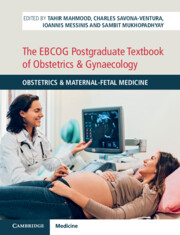Book contents
- The EBCOG Postgraduate Textbook of Obstetrics & Gynaecology
- The EBCOG Postgraduate Textbook of Obstetrics & Gynaecology
- Copyright page
- Dedication
- Contents
- Contributors
- Preface
- Section 1 Basic Sciences in Obstetrics
- Chapter 1 Surgical Anatomy of the Female Pelvis
- Chapter 2 Maternal Physiology during Pregnancy, Including Immunology of Pregnancy
- Chapter 3 Developmental Abnormalities of the Reproductive System and Their Relevance to Obstetric Practice
- Chapter 4 Pharmacology and Pharmacokinetics in Obstetric Practice
- Chapter 5 Genetics in Fetomaternal Medicine
- Section 2 Early Pregnancy Problems
- Section 3 Fetal Medicine
- Section 4 Maternal Medicine
- Section 5 Intrapartum Care
- Section 6 Neonatal Problems
- Section 7 Placenta
- Section 8 Public Health Issues in Obstetrics
- Section 9 Co-Morbidities during Pregnancy
- Index
- Plate Section (PDF Only)
- References
Chapter 5 - Genetics in Fetomaternal Medicine
from Section 1 - Basic Sciences in Obstetrics
Published online by Cambridge University Press: 20 November 2021
- The EBCOG Postgraduate Textbook of Obstetrics & Gynaecology
- The EBCOG Postgraduate Textbook of Obstetrics & Gynaecology
- Copyright page
- Dedication
- Contents
- Contributors
- Preface
- Section 1 Basic Sciences in Obstetrics
- Chapter 1 Surgical Anatomy of the Female Pelvis
- Chapter 2 Maternal Physiology during Pregnancy, Including Immunology of Pregnancy
- Chapter 3 Developmental Abnormalities of the Reproductive System and Their Relevance to Obstetric Practice
- Chapter 4 Pharmacology and Pharmacokinetics in Obstetric Practice
- Chapter 5 Genetics in Fetomaternal Medicine
- Section 2 Early Pregnancy Problems
- Section 3 Fetal Medicine
- Section 4 Maternal Medicine
- Section 5 Intrapartum Care
- Section 6 Neonatal Problems
- Section 7 Placenta
- Section 8 Public Health Issues in Obstetrics
- Section 9 Co-Morbidities during Pregnancy
- Index
- Plate Section (PDF Only)
- References
Summary
Over the past 160 years there have been many relevant breakthroughs and discoveries allowing the features that underlie both common and rare genetic conditions to be understood. The father of modern genetics, Gregor Mendel, provided an early recognition of human genetic variability using basic modes of inheritance after studying Pisum sativum, the common pea plant, in 1865 [1]. In 1953, James Watson and Francis Crick went on to describe the double helix structure of DNA [2]. This was then followed by the discovery of sequence reactions by Sanger and Coulson [3]. and the polymerase chain reaction technique by Mullis et al [4], which in turn helped make genome sequencing possible. The Human Genome Project was then completed on 21 October 2004, supplying the nucleotide sequence of all chromosomes [5].
- Type
- Chapter
- Information
- The EBCOG Postgraduate Textbook of Obstetrics & GynaecologyObstetrics & Maternal-Fetal Medicine, pp. 38 - 44Publisher: Cambridge University PressPrint publication year: 2021

